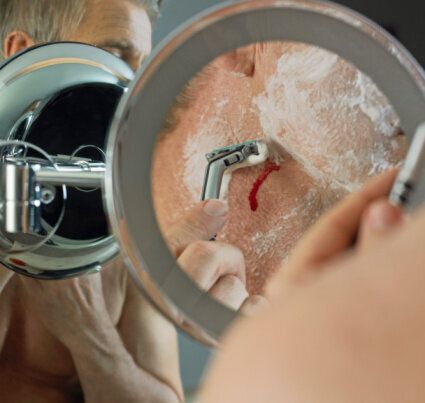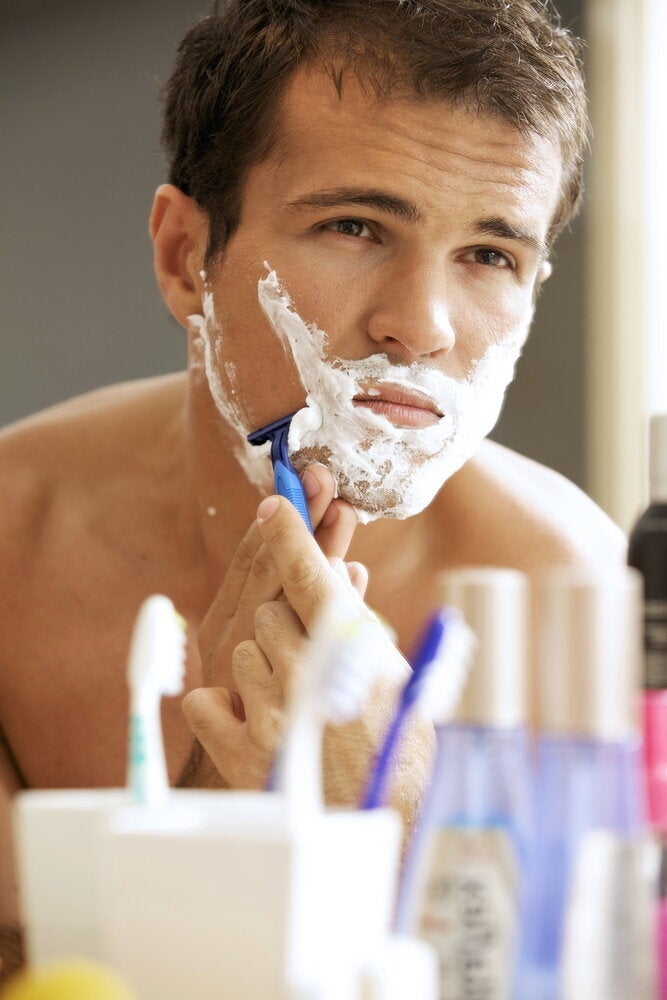
While some facial hair can be sexy, most men these days opt not to grow a full beard, as the barbarian look isn't exactly a girl-magnet. Unless you have the grooming habits of Tarzan, you inevitably have to shave several times a week. Shaving, however, comes with a few problems of its own; fortunately, most of these problems can be easily resolved. And here, to make shaving issues a thing of the past, is our guide to the most common facial hair problems and solutions.
Razor nicks and cuts
Small, seemingly insignificant lacerations or deep, ugly gashes that cause an outpouring of blood are the two types of injury you have probably experienced while wielding a razor. Dull razor blades are a common culprit of razor nicks, while applying too much pressure to a sharp blade can cause wounds of a more serious kind.
Solution: Sufficient lubrication, a high-quality razor and an antiseptic are your best friends when it comes to preventing razor-related catastrophes and for treating them when they occur.
Directions: First off, junk any cheap, disposable razors you may have lying around and invest in one with a swivel head designed to accommodate the contours of your face, and replace the blades often. A good rule of thumb is to use a new razor head once every eight shaves. Also, you can decrease your chances of having a shaving-related accident by selecting a shaving tool whose blades are spaced close together to reduce the amount of pressure you're putting on your skin.
Before shaving, spend two to three minutes in a steamy environment, like the shower, making sure your skin is very wet and has time to absorb a lot of moisture. Then lubricate using a rich shaving cream to protect your skin and to make it easier for your razor to glide over the surface of your face. Be sure to rinse your razor after each stroke.
For those times when a bloody slip-up occurs, keep an antiseptic on hand and dab with a cotton swab or apply an ice cube, as the cold will constrict your blood vessels and help stop the bleeding. Once your cut has healed slightly, use an aftershave that has a mild antiseptic in it and continue using the cotton swab to dab the damaged area.
Skin irritation/dryness
Skin irritation and dryness are problems brought on by multiple causes. Harsh chemicals can cause allergic reactions on sensitive skin. As well, improper shaving techniques can result in irritation. On darker skin, irritation can take the form of hyper pigmentation. Chaffing and itchiness are two symptoms that indicate you may be suffering from dry skin or another irritation.
Solution: Although razor burn usually clears up on its own within a few hours, there are precautionary steps you can take to avoid experiencing this unpleasant condition to begin with, including using the right products, the right razors and the right shaving techniques, and following everything up with a moisturizer.
Directions: If you know or suspect you have sensitive skin, only buy products specifically formulated for your skin type. A razor that has a built-in aloe strip and includes other ingredients such as vitamin E is a good choice. Avoid shaving with products containing sodium lauryl sulfate, a compound found in most soap that seriously dries skin. Instead, look for emollient-rich shaving creams or ones that contain aloe vera as they'll soothe your skin before, during and after shaving. When it comes to your technique, shave in the direction of hair growth first, only shaving in the opposite direction if your first round of shaving leaves any stray hairs behind. Don't give in to the temptation to shave too closely and never, ever dry shave or shave roughly when you're in a hurry. Lastly, use a moisturizer when your finished shaving if you have dry skin, looking for products that contain vitamins and shea butter.
Ingrown hairs
When a hair grows sideways into the skin, instead of breaking through the surface, you've got an ingrown hair on your hands (or more precisely, on your face). There are numerous causes for ingrown hairs. For instance, you may be more prone to getting ingrown hairs if you have coarse facial hair, if your skin lacks moisture or if your face is very oily. A buildup of dead skin cells can also block pores and increase your chances of having ingrown hairs. Improper shaving techniques can also lead to ingrown hairs and are, in fact, the most common cause of this condition.
Solution:Exfoliation, pore-opening tricks and proper shaving tools can all go a long way in preventing ingrown hairs or eliminating them should they appear.
Directions: Approximately once a week place a warm, damp facecloth over your face to open your pores, which will make it easier to coax out stubborn hairs. Then use a loofah along with a gentle facial scrub to slough off the dead skin on your face which would otherwise be blocking your hair follicles. Avoid using a loofah more frequently than this recommendation, however, as you don't want to dry out your skin, doing so will actually increase your chances of suffering from ingrown hairs.
Following these treatments, tweezers can help bring ingrown hairs to the surface, but resist the urge to pluck them out because they'll likely reappear and be worse than before. Lastly, keep in mind that putting a lot of pressure on your razor while shaving will mean you end up clipping your hair too close to your skin, increasing the likelihood that you'll be seeing ingrown hairs.
Razor bumps
Similar to yet slightly different than ingrown hairs, razor bumps happen when hair curls, then grows back into the skin, causing inflammation and, possibly, infection. This problem is more common in men of African or Mediterranean descent or men with very thick, curly hair. On the skin, razor bumps may resemble pimples.
Solution: You'll want to sort this problem out straight away because it can lead to scarring if you don't bother treating it; see a dermatologist if this pesky problem is currently plaguing you. To prevent this problem from happening in the future, alter your shaving technique or consider growing some facial hair.
Directions: If you love a clean-shaven look or your workplace requires it, switch to a single blade razor, shave with a light hand and try not to shave every day. What you're trying to avoid is shaving too closely because doing so will make it more difficult for your facial hairs to exit their follicles correctly. Have a browse through our facial hair style suggestions and see if you can get away with sporting a small but well-groomed beard. Once you've managed to get your facial hair to a length you like, you'll just need to trim it to maintain your look, meaning you won't have to shave as often or at the very least, you'll be shaving a much smaller area.
Face your problems
While women love well-groomed men, shaving can result in some not-so-pretty consequences. Hopefully by now you've identified any problems you suffer from and have armed yourself with knowledge that will assist you in both preventing and curing a number of common aggravations. Use proper shaving tools, the right techniques, pay attention to your skin type, and be mindful of any strange symptoms, and you'll be one step closer to skin that feels fresh and comfortable all the time.
